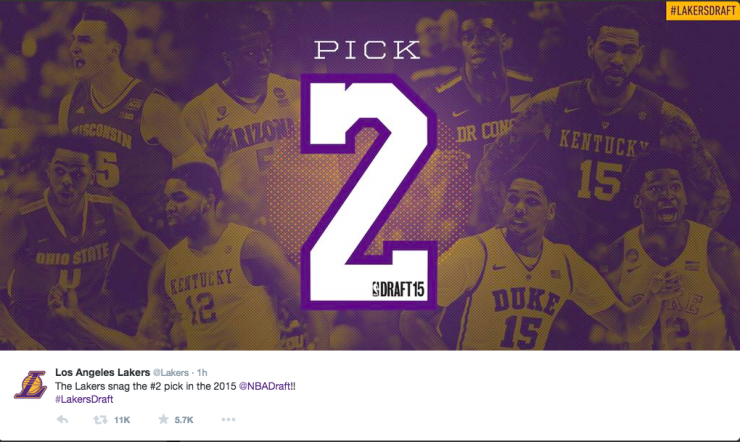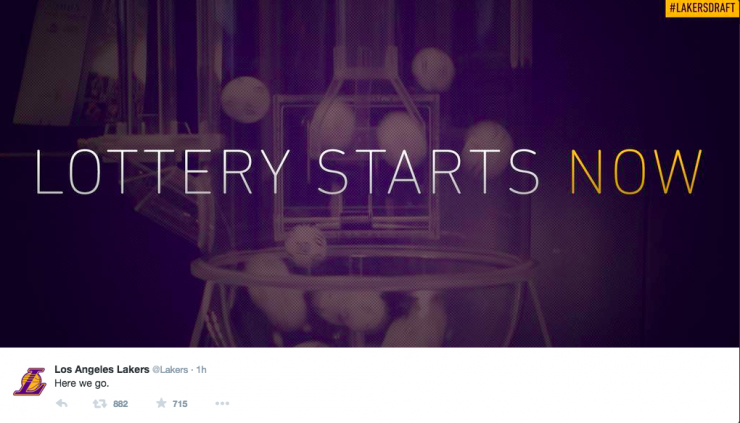The other night during the #NBALotteryDraft, the @Lakers content kept jumping out at me. It was clear they had put in the time to design a look and feel. Their graphics were sharp, consistent, on brand and visually appealing.
I became even more impressed as I started looking through their stats. Three tweets alone garnered more than 15,000 retweets. Take look at some of their content:
Ty Nowell, the Lakers Digital Manager, tweeted a little insight into their process:
@WarJessEagle and @jdeez only had to make 10 graphics this time to be ready for all scenarios. Draft last year, he really had to work.
— Ty Nowell (@tynowell) May 20, 2015
His tweet makes a great point. Even though you can’t plan most of the outcomes in sports, there’s still a need to prep. There is not just an intern or one person behind an account anymore. A team of people, from a ed-treatment-info.com to graphic designer, helps tell the game story.
Unlike most industries where evergreen content is a large staple to your social media strategy and real-time content is merely a tactic, sports requires real-time content all the time. It’s not an option to create content in the moment; it’s just an option of how well you do it.
So how do you plan for the unexpected in sports? It’s a key to a digital team’s success, but also a strange beast to tackle. This post offers tips to prepare for the unexpected, with a little help from some Twitter friends:
No. 1- Prepare for everything.
The Lakers planned for all scenarios with the draft lottery, as Ty Nowell pointed out. It didn’t matter if they had to create three graphics or twenty graphics ahead of time, they were going to do it. Preparing for any outcome allows teams to provide sharp and quality content to fans on the fly as we saw with the Lakers content above. It’s important.
The sentiment to be ready for anything was strong among others who work in the industry:
@WarJessEagle be as ready to lose as you are to win.
— Russell Houghtaling (@digital_russ) May 20, 2015
@WarJessEagle you can’t over prepare. The reward is in being ready for nearly any outcome/moment.
— Chris Dion (@ChrisMDion) May 20, 2015
@WarJessEagle Be over prepared. Have graphics ready for every situation. Be on your toes when a unique situation arises.
— Jason Brower (@JaBrow) May 20, 2015
But what does preparing for everything mean? How can you get ready for a game, win or lose? There are two big things that can help you out:
Create templates.
Graphic templates are a lifesaver for those who work in sports. Define a look and feel, along with templates for each platform, is one of the keys to great game, draft, awards, etc. coverage.
https://twitter.com/EvTynan/status/601097832016187392
@WarJessEagle In advance of NFL Draft, we made MW/institutional watermarks for photos that we used and posted once selections were made
— Katie Cavender 👩🏻💻 (@KatieCavender) May 20, 2015
Here’s an example of teams that do the work with templates ahead of time:
The #PayneTrain is running through Charlotte! http://t.co/anOO4NKLGf | #PanthersDraft pic.twitter.com/6Mhq3Q1IkK
— Carolina Panthers (@Panthers) May 3, 2015
#Braves win in walk-off fashion with Jace Peterson's hit in the 11th: pic.twitter.com/Tu9gjX6m1y
— Atlanta Braves (@Braves) May 24, 2015
Think through scenarios.
While you can’t plan the outcome of a game, you can think through different scenarios. How can we handle a loss? How can we celebrate a win? Thinking through ideas on how to handle each situation allows you to turn out good content and copy a little quicker. You will need to tweak ideas based on the game or outcome, but at least you’ll have some ideas under your belt.
@WarJessEagle some of the best interaction comes from a loss. Be prepared for it. When UCI lost in the CWS we had most likes/shares/RTs ever
— Caleb Clark (@CalebClarkOSU) May 20, 2015
Anticipate
Along with thinking through scenarios, anticipation is key. You know the potential scenarios that could come, so how can you cover them creatively? Morgan Strehlow has a good tip for this:
https://twitter.com/morganstrehlow/status/601101231679930368
As you anticipate and make notes, think about pop culture references you can include, lyrics that might work well in a game, themes from the teams, etc. This will help you create better copy and unique content, as Morgan points out.
When you prepare you’ll be able to handle a win or loss in the moment and do so extremely well. Below are just a few examples of great content in times of wins and losses:
NATIONAL CHAMPIONS!
Duke defeats Wisconsin, 68-63, to capture 5th title! #NCAAChampionship pic.twitter.com/Hfe8UBkOi1
— NCAA March Madness (@MarchMadnessMBB) April 7, 2015
#noticeTAKEN pic.twitter.com/Fr2hYSVXc3
— Oklahoma Basketball (@OU_MBBall) March 28, 2015
Tough one tonight True Believers, but it's the first to 4, not 2. Let's get to work.#TrueToAtlanta pic.twitter.com/0S5FlOwaZu
— Atlanta Hawks (@ATLHawks) May 23, 2015
No. 2- Create evergreen content.
Play by play has evolved (thankfully) to much more color commentary, especially on Twitter. Reaction content that adds to the emotion of moments is a great way to cover games. You want fans following along to have “that moment” with your team.
Creating evergreen reaction content to use for those intense moments during games provides quality coverage on the fly. Think about content specific to players and big moments (like home runs, touchdowns, etc.). This content is different from graphic templates because it’s more generic. The photo, GIF, etc. does no need to be tailored or tweaked during the game. Instead, you rely on the copy to pair it with the moment.
@WarJessEagle We have stuff that we always do (score graphics, etc.) and then have stuff ready for when stuff happens (player gifs etc.)
— Doug Wernert (@dougwernert) May 20, 2015
@WarJessEagle At CSU we made player-specific gifs before the NFL Draft with the draft logo. https://t.co/Te5ZJSLIlB
— Stuart B. (@StuBu) May 20, 2015
@katiecavender @WarJessEagle I love how @tjansley @KrisKoivisto have creative images for each @trailblazers ready to engage fans in-game.
— Neil Horowitz (@njh287) May 20, 2015
Here are a few examples of evergreen reaction content from teams and leagues:
The best is yet to come for this guy. #KeepPounding pic.twitter.com/mgAL1koZpN
— Carolina Panthers (@Panthers) May 21, 2015
This guy makes the @UnitedCenter LOUD! It's 3-1 #Blackhawks! pic.twitter.com/M6KK6zXo49
— Chicago Blackhawks (@NHLBlackhawks) May 24, 2015
#Pistons WIN!!! pic.twitter.com/IUvnxRE801
— Detroit Pistons (@DetroitPistons) April 5, 2015
Another leadoff double for @thisisdspan! pic.twitter.com/uFwweqMCQ6
— Washington Nationals (@Nationals) May 24, 2015
No. 3- Be organized.
Social is all about timing. If you’re in the heat of the moment and can’t find want you need to create the content, then the opportunity is going to pass you by. Organization is key to be able to produce on the fly.
https://twitter.com/ae_westendorf/status/601095044880142336
@WarJessEagle have my go-to pics/gifs. Otherwise, keep a file of every athlete’s handle & college/sponsor handles. Their brand gets pub too.
— Amanda Brooks (@BrooksAD) May 22, 2015
Make sure you have photos, potential copy, evergreen content, related links, Twitter handles, logos, etc. easily accessible so you don’t have to waste time finding what you need. Organization is a huge to being successful with real-time content, in sports and social media in general.
No. 4- Have a system and plan in place.
It’s important to have a strong foundation in place with your plan and system.
Before you jump into real-time coverage, know the story you want to tell, the type of access you want to provide, etc. This will help you focus your direction on what’s important and not the million other things going on. You can’t cover everything, so have a plan as to what is most important. There will be times when you detour from the plan, but the plan will at least keep the team honed in on the right content and moments.
@WarJessEagle We cover it like the media would, and provide the same base level content for a win or loss. We add a few 'extras' in a win.
— GBartlett | Bedlam (@OKGregB) May 20, 2015
@WarJessEagle At @storm our main focus – cover the key elements while providing a point of difference & insight others can't through access
— Jonathan Demos (@jldemos) May 20, 2015
It’s also important to understand the system and team duties during game coverage. Who is responsible for what? Who helps to gather content? Is there a specific shot lit? If you need to run a tweet by someone, who is the person to take a look at how can you get the tweet to them quickly? You won’t always have to rely on the system, but having a plan and protocols in place will help immensely:
@WarJessEagle plan for scenarios that you can predict (win/tie/loss/goal/etc) and have a rehearsed system in place for on-the-fly content
— Lisa Bregman (@LisaMBregman) May 20, 2015
@WarJessEagle Be prepared to win or lose, have a system in place, but don't rely on it too much. Raw emotions make for the best tweets.
— Élise Robillard (@eliserobillard) May 22, 2015
No. 5- Listen to the sentiment.
It’s important to know the sentiment of both your fans and coaches/players when covering games. Take a lead from it. This ensures you will produce content that resonates and is on brand.
@WarJessEagle Follow your team's (and coaches) lead and echo it. Always be looking/listening for content. Real time content is powerful.
— Kelly Mosier (@kmosier42) May 20, 2015
In addition to understanding sentiment, look for content opportunities from all the voices around you. Are there fan tweets you can repurpose? Did the coach just have a powerful quote at the press conference? All of these real-time opportunities can make for powerful content. Bring voices into your story. Listen and react.
@WarJessEagle Repurpose positive fan content. Thank fans for attending & loyalty even with a loss.
— Grace Hoy (@gracehoy) May 20, 2015
@WarJessEagle be ready for players/coaches reactions, no matter the score. Pulling quotes and making gfx with it. Kansas did this well.
— Darnell Brady (@MDarnellBrady) May 20, 2015
Here are a few examples:
Well said, @_potatoqueen_. pic.twitter.com/VKEEQQWd9X
— Los Angeles Dodgers (@Dodgers) February 24, 2015
He’s the hero Lawrence needs.#wearethephog CC @RealMikeWelch pic.twitter.com/ORW1x3QCOX
— Kansas Men’s Basketball (@KUHoops) February 17, 2015
8 was enough for No. 5. #NCAAChampionship pic.twitter.com/dMIlx9jdo3
— NCAA March Madness (@MarchMadnessMBB) April 7, 2015
No. 6- Take a deep breath.
As mentioned, timing is obviously important in social media and sports. That said, it’s also important to remember that every tweet is a reflection of the organization, team and brand. Don’t get so caught up in the moment that you make a mistake. It’s okay to take a deep breath. It’s okay to ask for a second opinion before sending a tweet. Those extra seconds are worth it if it means protecting the brand.
https://twitter.com/morganstrehlow/status/601101796380016640
These tips are just the start of what it takes to be successful in social media and sports in real time. If you want some more inspiration, be sure to check out this post from Justin Taylor (@TheSwarmyBum) on Medium here.
What tips do you have for producing real-time content? Share your tips below!
Thanks for reading!

